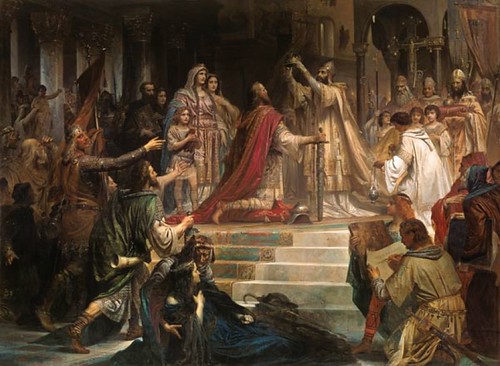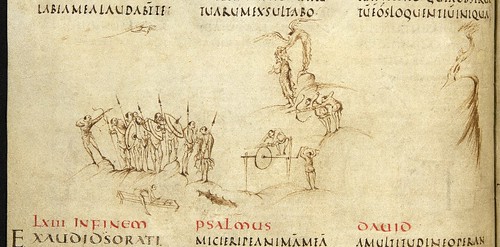 |
| Pope Leo III crowns Frankish king Charlemagne Emperor of West |
What was the reason for this cultural gap happened? First, after conquering vast territories, Frankish rulers needed an educated administration in different pieces of the empire to manage these very lands. But after Dark Ages, this was a difficult thing to find them. Secondly, the classical Latin, which was that time an international language, began to come in decline in France. It became harder and harder to maintain communication with the pope. Simultaneously, Latin in France gradually became a Frankish dialect. To remedy the situation, Charlemagne decided to organize something like an academy in his palace and invited the most prominent theologians from Europe, such as Alcuin from the British York or Paul Diacon from Italy and so on.
 |
| Detail of the Utrecht Psalter, a masterpiece of Carolingian art |
First of all, the Carolingian revival is characterized by the appearance of several hot medieval miniatures. For example, in Utrecht Psalter there are as many as 166 pictures depicting every kind of chants, musical instruments and cleric’s subjects. Naturally, this cultural breakthrough was connected with the clerics: the manuscripts were made by monks, miniatures depict the life of monasteries and saints, architectural trends were implemented in churches and monasteries, music was mostly monotonous Gregorian singing. A list of the most notable works of the era can be seen here. But, there was interest to the ancient manuscripts as well, and it was early time since ancient times. No one century, from the fourth to the fourteenth, was characterized by so many rewritten ancient manuscripts. Even the description of ancient pagan rituals and beliefs did not bother the clerics.
Revival showed itself not alone in the field of art. Charlemagne decided to carry out monetary and legislative reforms as well and even succeeded in it. In general, politically and culturally, Europe that time was even more integrated than currently, IMHO.
Комментариев нет:
Отправить комментарий